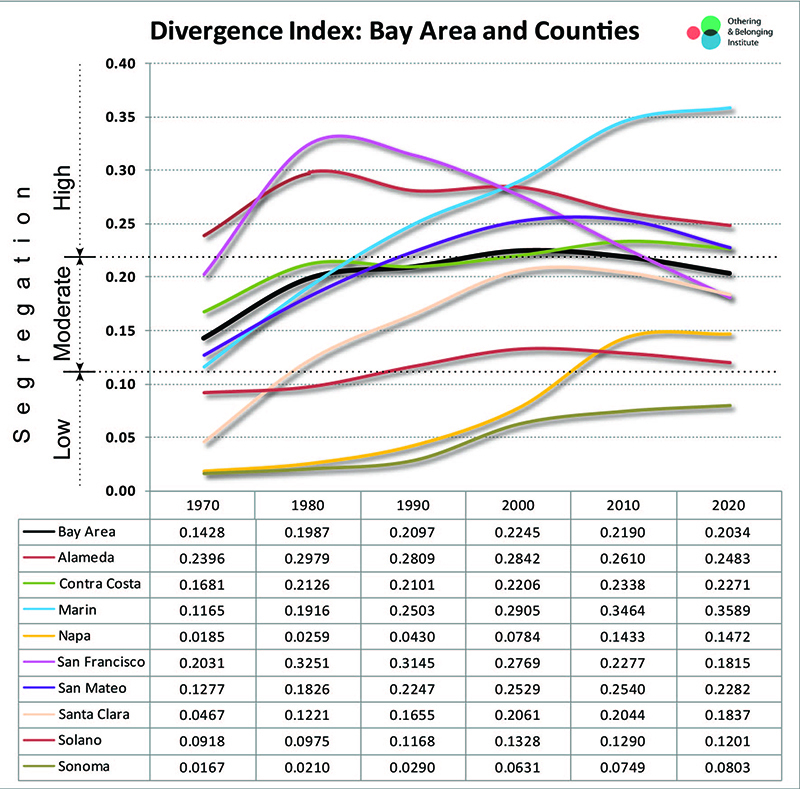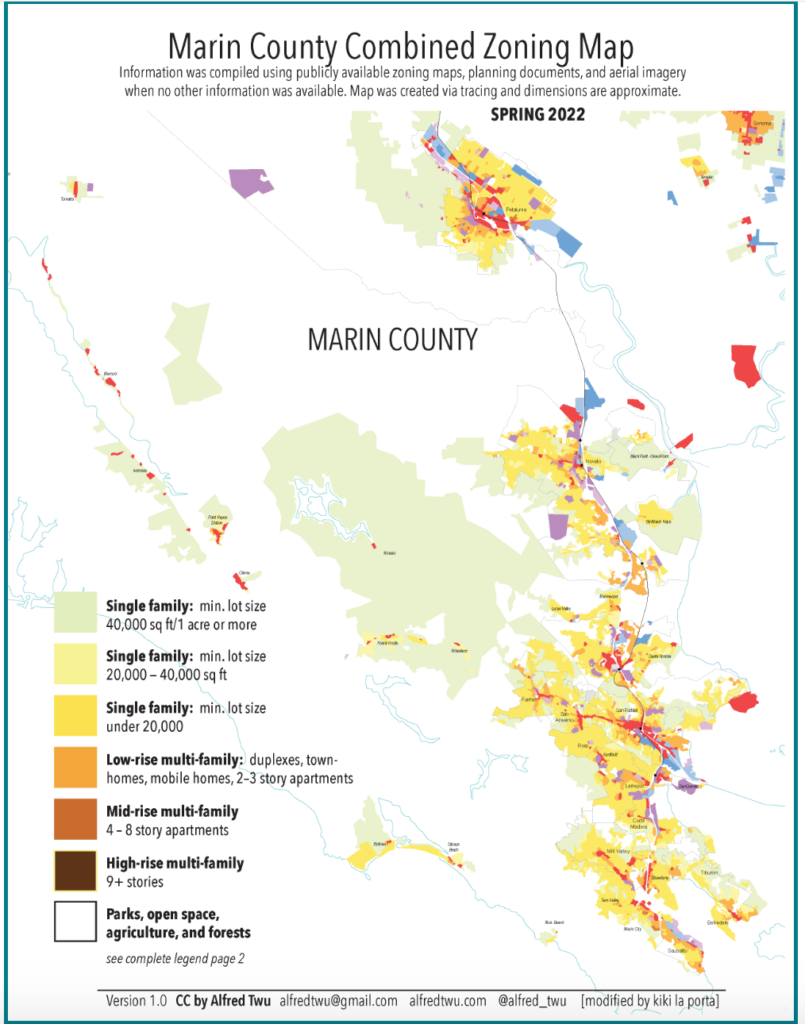Perspective: Why is Marin so White?
| Marin County is more racially segregated than ever. |
 Marin County is more racially segregated than ever, and we have a severe shortage of affordable housing [note]. Many Marinites consider these issues to be unrelated, but they are linked. Social justice is a component of MEHC’s mission, and so we strive to evaluate housing through a racial equity lens. A racial equity lens pushes us to evaluate “the impact of unintended consequences by taking into consideration the lived experiences and perspectives of racially diverse communities” [note]. It allows us to acknowledge and discover the impacts our local, state, and federal regulations and institutions have had on communities of color. It enables us to see how seemingly-neutral policies have resulted in highly segregated communities. So, why is Marin so White, and what can we do about it? To properly use the racial equity lens, if we are not a person of color, means we must understand our privilege. The term “privilege” is uncomfortable and challenging for many. Writer John Scalzi describes privilege best in his essay [note] when he explains privilege means that generally our actions result in better outcomes than when a less privileged person does the exact same actions. We are more likely to be given the benefit of the doubt, get a pass on bad behaviors or mistakes, or be given an opportunity based on potential rather than a track record. Realizing our inherent societal benefits can raise uncomfortable feelings, but it’s important to accept this reality if we want to create change. The first step requires acceptance of the undeniable fact that Marin County’s segregation problems directly stem from housing discrimination. As Craig Gurian has stated, “You really cannot name any significant social injustice problem in the United States that’s not undergirded by residential housing segregation” [note]. |

“Divergence” is effectively an index of segregation. Marin shows a steadily increasing “divergence” or “segregation index” over the past 50 years. See more at the Berkeley Center for othering and belonging.
Formerly common policies have produced enduring effects of racism
Some policies and practices in the past were quite explicit in their racism, such as redlining, blockbusting, and racially restrictive covenants. This was not specific to Marin County; it was a problem nationwide [note]. And while there are now laws in place to combat this kind of overt racism, there are lasting effects of these formerly common policies. Significantly, these policies and practices greatly restricted the ability for non-White families to purchase homes, with the result that these families have not been able to participate in the enormous multi-generational wealth gained from the increasing home prices in Marin. Many Marinites used the increases in home equity to fund college and other educational opportunities for their children and to provide security in old age. Black residents have been largely shut out of these opportunities.
Despite the appearance of neutrality, many current housing policies effectively limit the housing available to communities of color. Economic zoning laws such as minimum lot size requirements, single family zoning, and laws that limit housing density are technically race-neutral, but they keep racial segregation alive and well. Zoning laws are generally justified by the need to separate residents from health and safety risks. However, economic zoning cannot be justified on this basis. When explicit housing discrimination was outlawed, the loophole that was created was the formation of economic zoning.

In other words, if we keep single family zoning and our high housing prices, racial segregation will remain. Said differently, if we do not want our community to be segregated, then we must build more housing. Click Marin’s Residential Zoning map at left to download. Note that the largest land areas (white) are zoned agricultural/open space. From green through yellow and light orange, the zoning allows only single family homes. Building more housing In Marin will require approval of multi-family housing, as that is the only way to achieve affordability, and affordability is the only way to achieve integration and housing justice for all. It will also enable our workforce to live in Marin, leading to a better quality of life for everyone. Workers will not have to endure soul-crushing commutes and current residents will benefit from increased services and a larger employee base. Marin is one of the most segregated places to live in the entire country, to our county’s shame. Not pushing for change is the biggest problem we face now.
Community character and “charm” vs keeping the status quo
To this day, some of the most common arguments we hear in almost all local City Council and Planning Commission meetings throughout Marin is that “we do not want to ruin the character of our community,” or that introducing anything other than single family homes in neighborhoods would take away our “charm.” These are just coded ways of saying “we want to maintain the status quo.” But when that status quo is single family zoning, a lack of adequate workforce housing, and racial segregation — it is not worth maintaining. There are no community benefits from a segregated single family zoned community. There are no health and safety benefits of economic zoning. Keeping Marin racially segregated is not what we believe most residents want. In order to change this we must push back against the idea that Marin can never change. Everyone benefits when a community is inclusive.
A quote from Richard Rothsteins’ The Color of Law summarizes this need to change and acknowledge the harmful impacts of the history of housing, “If segregation was created by accident or by undefined private prejudices, it is too easy to believe that it can only be reversed by accident or, in some mysterious way, by changes in people’s hearts. But if we—the public and policy makers—acknowledge that the federal, state, and local governments segregated our metropolitan areas, we may open our minds to considering how those same federal, state, and local governments might adopt equally aggressive policies to desegregate.”
The only way to accomplish this is to support the building of more housing. White residents in particular need to advocate for a more affordable and integrated county. The challenges commonly cited – traffic, crime, water, and environmental impacts – are not issues caused by housing and cannot be addressed by refusing to build housing. Communities benefit from integration. If we feel scared to see our neighborhood implement more housing, we need to ask ourselves why. What are we upholding? Why must everything stay stuck in time and never change? Marin County is a beautiful place that is highly sought after for a reason, but it is a disservice to all residents to not acknowledge our racist past and change things now. Everyone deserves a chance to call Marin home, or, said differently, are we for JUSTICE, or JUST US?
| RESOURCES |

